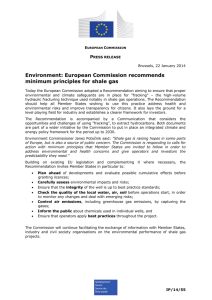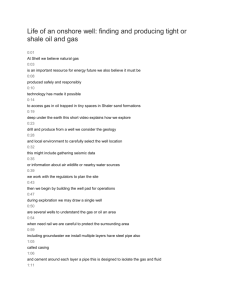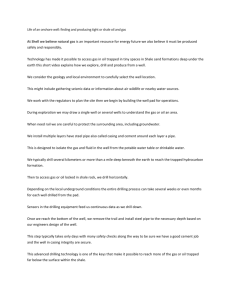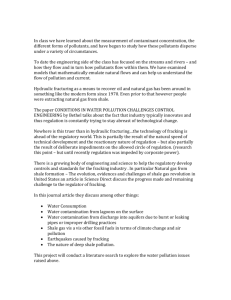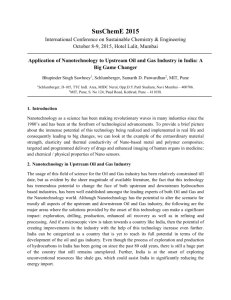Tyndall_Report_Summary
advertisement
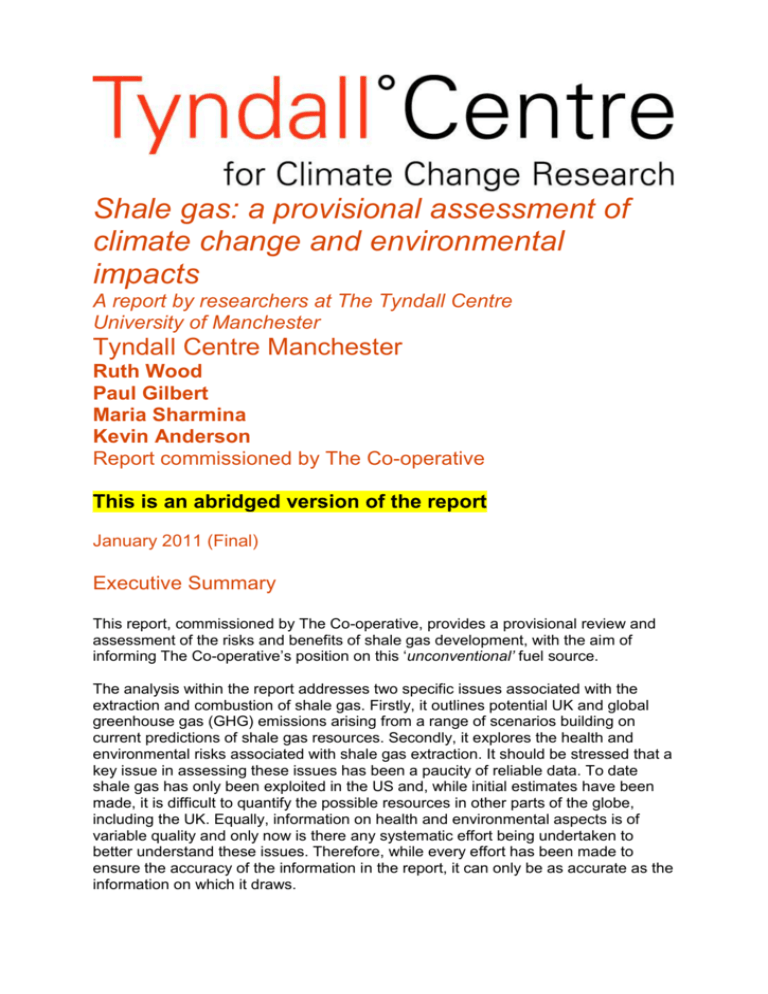
Shale gas: a provisional assessment of
climate change and environmental
impacts
A report by researchers at The Tyndall Centre
University of Manchester
Tyndall Centre Manchester
Ruth Wood
Paul Gilbert
Maria Sharmina
Kevin Anderson
Report commissioned by The Co-operative
This is an abridged version of the report
January 2011 (Final)
Executive Summary
This report, commissioned by The Co-operative, provides a provisional review and
assessment of the risks and benefits of shale gas development, with the aim of
informing The Co-operative’s position on this ‘unconventional’ fuel source.
The analysis within the report addresses two specific issues associated with the
extraction and combustion of shale gas. Firstly, it outlines potential UK and global
greenhouse gas (GHG) emissions arising from a range of scenarios building on
current predictions of shale gas resources. Secondly, it explores the health and
environmental risks associated with shale gas extraction. It should be stressed that a
key issue in assessing these issues has been a paucity of reliable data. To date
shale gas has only been exploited in the US and, while initial estimates have been
made, it is difficult to quantify the possible resources in other parts of the globe,
including the UK. Equally, information on health and environmental aspects is of
variable quality and only now is there any systematic effort being undertaken to
better understand these issues. Therefore, while every effort has been made to
ensure the accuracy of the information in the report, it can only be as accurate as the
information on which it draws.
It is clear however, that while shale gas extraction, at a global level, does not involve
the high energy and water inputs at the scale of other unconventional fuels, such as
oil derived from tar sands, it does pose significant potential risks to human health
and the environment. Principally, the potential for hazardous chemicals to enter
groundwater via the extraction process must be subject to more thorough research
prior to any expansion of the industry being considered. Additionally, while being
promoted as a transition route to a low carbon future, none of the available
evidence indicates that this is likely to be the case. It is difficult to envisage any
situation other than shale gas largely being used in addition to other fossil fuel
reserves and adding a further carbon burden. This could lead to an additional
11ppmv of CO2 over and above expected levels without shale gas – a figure that
could rise if more of the total shale gas resource were to be exploited than envisaged
in the scenarios. This would be compounded if investment in shale gas were to delay
the necessary investment in zero and very low carbon technologies.
Key conclusions: general
Evidence from the US suggests shale gas extraction brings a significant risk
of ground and surface water contamination and until the evidence base is
developed a precautionary approach to development in the UK and Europe is
the only responsible action. The depth of shale gas extraction gives rise to major
challenges in identifying categorically pathways of contamination of groundwater by
chemicals used in the extraction process. An analysis of these substances
suggests that many have toxic, carcinogenic or other hazardous properties.
There is considerable anecdotal evidence from the US that contamination of both
ground and surface water has occurred in a range of cases. This has prompted the
US Environmental Protection Agency (US EPA) to launch a research programme to
improve understanding of this risk (timetabled to provide initial results towards the
end of 2012).
Action has also been taken at State level, for example, on 11 December 2010 the
New York State Governor issued an Executive Order requiring
further review and analysis of high-volume hydraulic fracturing in the Marcellus Shale
and cessation of fracturing until 1 July 2011 at the earliest. The analysis in this report
clearly demonstrates that the risks associated with the cumulative impact of drilling
sufficient wells to provide any meaningful contribution to the UK’s energy needs
cannot be dismissed, however low they might be at the individual well level. Given
the requirement for EU member states to apply the precautionary principle,
shale gas exploitation should be delayed until at least after the EPA has
reported and, depending on the findings, perhaps longer. There is little to
suggest that shale gas will play a key role as a transition fuel in the move to a
low carbon economy. Measured across their respective lifecycles the CO2
emissions from shale gas are likely to be only marginally higher than those
from conventional gas sources.
Without a meaningful cap on emissions of global GHGs, the exploitation of
shale gas is likely to increase net carbon emissions. In an energy-hungry world,
where GDP growth continues to dominate political agendas and no effective and
stringent constraint on total global carbon emissions is in place, the exploitation of an
additional fossil fuel resource will likely increase energy use and associated
emissions.
Rapid carbon reductions require major investment in zero-carbon
technologies and this could be delayed by exploitation of shale gas. The
investment required to exploit shale gas will be substantial.
Requirements for water in shale gas extraction could put considerable
pressure on water supplies at the local level in the UK. Shale gas extraction
requires high volumes of water.
Exploiting shale gas within the UK is likely to give rise to a range of additional
challenges. The risk of aquifer water supply contamination by the hazardous
chemicals involved in extraction is likely to be a significant source of local
objections. Additionally, the UK is densely populated and consequently any wells
associated with shale gas extraction will be relatively close to population centres.
The proximity of such extraction will give rise to a range of local concerns, for
example: drilling will require many months if not years of surface activity leading to
potentially intrusive noise pollution; high levels of truck movements during the
construction of a well-head will have a major impact on already busy roads; and the
considerable land-use demands of shale gas extraction will put further pressure on
already scarce land-use resources. This new availability and apparent abundance of
shale gas in the US (and potentially elsewhere) has led some to argue that shale gas
could, in principle, be used to substitute (potentially) more carbon intensive fuels
such as coal in electricity generation. On this basis it has been argued that
expanding production of shale gas could represent a positive transitional step
towards a low carbon economy in the US and potentially elsewhere and it has been
referred to as a ‘bridging fuel’. In addition to outstanding questions concerning the
magnitude of any potential GHG benefits of shale gas (or otherwise), the drilling and
hydraulic fracturing technologies required for shale gas production also bring with
them a number of negative environmental impacts and risks. These include:
surface and groundwater contamination associated with chemicals used in the
hydraulic fracturing process and the mobilisation of sub-surface contaminants such
as heavy metals, organic chemicals, and naturally occurring radioactive materials
(NORMS); hazardous waste generation and disposal; resource issues including
abstraction of significant quantities of water for hydraulic fracturing processes;
and land use, infrastructure and landscape impacts.
Some state regulators are moving towards moratoria on hydraulic fracturing while
risks are assessed. In New York State, for example, on 3 August 2010 the State
Senate passed a Bill to suspend hydraulic fracturing for the extraction of natural gas
or oil until 15 May 2011 (and to suspend the issuance of new permits for such
drilling). On 11 December 2010, the New York State Governor vetoed the Bill and
issued an Executive Order directing the Department of Environmental Conservation
(DEC) to “conduct further comprehensive review and analysis of high-volume
hydraulic fracturing in the Marcellus Shale”. The Executive Order requires that highvolume, horizontal hydraulic fracturing would not be permitted until 1 July 2011 at the
earliest
As such, issues for consideration in the study include:
the likely carbon footprint (i.e. lifecycle emissions) of shale gas relative to
other primary energy sources such as coal, and conventional natural gas;
the magnitude of known resources and the likely contribution to total
atmospheric CO2e from extracting and burning recoverable shale gas reserves; and
key environmental risks and impacts associated with shale gas
development including: water consumption; ground and surface water contamination
from hydraulic fracturing chemicals and other contaminants; and any other issues
that may be of concern from a UK sustainability perspective.
2. Shale gas production and reserves
2.1 Overview
Gas shales are formations of organic-rich shale, a sedimentary rock formed from
deposits of mud, silt, clay, and organic matter. In the past these have been regarded
merely as relatively impermeable source rocks and seals for gas that migrates to
other deposits such as permeable sandstone and carbonate reservoirs that are the
target of conventional commercial gas production. With advances in drilling and well
stimulation technology (originally developed for conventional production), however,
‘unconventional’ production of gas from these, less permeable, shale formations can
be achieved.
Development and combined application of horizontal drilling and hydraulic fracturing
have unlocked the potential for production of gas from these ‘tighter’ less permeable
shale formations and, as noted in Section 1, to date the most rapid and significant
development of shale gas and associated processes has been in the US. There,
shale gas production has expanded from around 7.6bcm in 1990 (or 1.4% of total US
gas supply) to around 93bcm (14.3% of total US gas supply) in 2009 (EIA, 2010b).
Based on US experience, this section provides detail on the modern processes
involved in the production of shale gas and an overview of estimated reserves and
levels of historical (and future) production in the US. It also provides information on
the known status of any reserves and reserve development in the UK and EU, where
development of shale gas is in its very earliest and exploratory stages.
2.2 Shale gas production processes
2.2.1 Introduction to shale gas processes
As noted above, horizontal drilling and hydraulic fracturing are the two technologies
that, in combination with one another, deliver the potential to unlock tighter shale gas
formations.
Hydraulic fracturing (also known as ‘fracking’) is a well stimulation technique which
consists of pumping a fluid and a propping agent (‘proppant’) such as sand down the
wellbore under high pressure to create fractures in the hydrocarbon-bearing rock.
These fractures start at the injection well and extend as much as a few hundred
metres into the reservoir rock. The proppant holds the fractures open, allowing
hydrocarbons to flow into the wellbore. Between 15% and 80% of the injected
fluids are recovered to the surface (US EPA, 2010). Directional/horizontal drilling
allows the well to penetrate along the hydrocarbon bearing rock seam, which may be
less than 90m thick in most major US shale plays. This maximises the rock area that,
once fractured, is in contact with the wellbore and, therein, maximises well
production in terms of the flow and volume of gas that can be obtained from the well.
Figure 2.1 illustrates a hydraulically fractured
horizontal well.
Whilst some conventional gas wells have been stimulated using hydraulic
fracturing methods, hydraulic fracturing and horizontal drilling is more of an
absolute requirement for shale wells to be sufficiently productive to provide a
financial return.
Multi-well pads
Horizontal drilling from multi-well pads is now the common development method
employed in, for example, ongoing development of Marcellus Shale reserves in the
northern Pennsylvania. Here a ‘well pad’ is constructed typically in centre of what
will be an array of horizontal wellbores similar to that shown in Figure 2.2. It is
reported that up to sixteen but more commonly six or eight wells are drilled
sequentially in parallel rows from each pad, each well typically being around 58m apart. Each horizontal wellbore may typically be around 1-1.5km in lateral
length but can be more.
In terms of spacing of well pads, New York State (2009) identifies a maximum
spacing of nine pads per square mile (2.6km2). This is equivalent to around
3.5pads/km2.
2.2.2 Pre-production - Initiation and drilling phase
Well pad construction
As described above, horizontal drilling from multi-well pads is now the common
development method with six or eight wells drilled sequentially from a single pad.
Each pad requires an area sufficient to accommodate fluid storage and equipment
associated with the high-volume fracturing operations as well as the larger
equipment associated with horizontal drilling.
According to New York State (2009), an average sized multi-well pad is likely to
be 1.5-2ha in size during the drilling and fracturing phase, with well pads of over
2ha possible. Average production pad size (if partial reclamation occurs) is likely to
average 0.4-1.2ha.
In terms of cuttings, a single well drilled vertically to a depth of 2km and laterally by
1.2km would generate around 140m3 of cuttings. A six well pad will, then, generate
around 830m3 of cuttings. For comparison, a conventional well7 drilled to the same
depth (2km) would generate around 85m3.
1. Well head and frac tree with
‘Goat Head’
2. Flow line (for flowback & testing)
3. Sand separator for flowback
4. Flowback tanks
5. Line heaters
6. Flare stack
7. Pump trucks
8. Sand hogs
9. Sand trucks
10. Acid trucks
11. Frac additive trucks
12. Blender
13. Frac control and monitoring
center
14. Fresh water impoundment
15. Fresh water supply pipeline
16. Extra tanks
17. Line heaters
18. Separator-meter skid
19. Production manifold
Fracturing fluid
The composition of the fracturing fluid varies from one product to another and the
design of the fluid varies depending on the characteristics of the target formation and
operational objectives. However, the fracturing fluid used in modern slickwater
fracturing is typically comprised of around 98% water and sand (as a proppant) with
chemical additives comprising 2% (GWPC, 2009b).
Fracturing procedure
The fracturing procedure is carried out sequentially (one well after another) and often
in multiple stages for each well.
Water and chemical additive requirements
Each stage in a multi-stage fracturing operation requires around 1,100-2,200m3 of
water, so that the entire multi-stage fracturing operation for a single well
requires around 9,000-29,000m3 (9-29megalitres {or about 10 Olympic
swimming pools}) of water and, with chemical additives of up to 2% by volume,
around 180-580m3 of chemical additives (or 180-580tonnes based on relative
density of one). For all fracturing operations carried out on a six well pad, a total of
54,000-174,000m3 (54-174megalitres) of water would be required for a first
hydraulic fracturing procedure and, with chemical additives of up to 2% by volume,
some 1,000-3,500m3 of chemicals (or 1,000-3,500tonnes based on relative density
of one).
Note: an Olympic swimming pool holds 2.5 million litres of water
1 m3 is 1000 litres
Fluid return
Once the fracturing procedure itself is completed, fluid returns to the surface in a
process stage referred to as ‘flowback’. Flowback fluid recovered from wells is
reported to be between 9% and 35% of the fracturing fluid pumped from horizontal
Marcellus wells in the northern tier of Pennsylvania range but US EPA (2010) notes
that “estimates of the fluids recovered range from 15‐80% of the volume
injected depending on the site”.
Accordingly, each well on a multi-well pad will generate between 1,300 – 23,000m3
of flowback waste fluid containing water, fracturing chemicals and subsurface
contaminants mobilised during the process, including toxic organic
compounds, heavy metals and naturally occurring radioactive materials
(NORMs).
The dimensions and capacity of on-site pits and storage tanks are likely to vary but,
based on volumes calculated above, total capacity would have to be in excess of the
expected volumes of flowback water from a single well fracturing operation, namely
between 1,300–23,000m3.(or up to 10 Olympic swimming pools full of waste)
Based on the typical pit capacity above, this implies up to around
20,000m3 of additional storage capacity for flowback water from one fracturing
operation on a single well (New York State, 2009).
In terms of overall flowback, water volume for a six well pad is suggested to be 7,900
to 138,000m3/pad (say about 50 Olympic swimming pools full of water and chemical
waste)for a single fracturing operation, with fracturing chemicals and
subsurface contaminants making up to 2% or 160-2,700m3.
2.2.4 Pre-production - duration of pre-production surface operations and transport
requirements
Table 2.4 summarises operations, materials, activities and typical duration of
activities prior to production from a multi-well pad. Based on the duration of
activities, the total pre-production duration of activities for a six well multi-well
pad is 500-1,500days of activity, assuming no overlap between activities (in
practice, there is some limited potential for overlap)
These are summarised in Table 2.5 giving trips per well and per well pad (based on
a six well pad). This suggests a total number of truck visits of between 4,300 and
6,600 of which around 90% are associated with the hydraulic fracturing operation.
Table 2.5:
Re-fracturing
As can be seen from the production from a well, production tails off significantly after
five years or so.
3. Estimation of GHG implications of shale gas
3.1 Introduction
This section responds to three key questions:
1) How much energy and GHG emissions are associated with the extraction
and processing of shale gas compared to gas derived from conventional
sources?
2) Assuming there are additional GHG emissions associated with the
extraction of natural gas from shale, do these additional emissions
outweigh the direct emissions savings from combusting natural gas rather
than coal?
3) What contribution could the combustion of shale gas make to UK and
global emissions?
3.2.1 ’Additional’ emissions associated with the extraction from shale on a per well
basis
The extraction of natural gas from conventional sources and shale reservoirs on
land-based wells follow many of the same procedures as outlined in Section 2.2.
Emissions during extractions can be divided into three main sources:
1) Combustion of fossil fuels to drive the engines of the drills, pumps and
compressors, etc, required to extract natural gas onsite, and to transport
equipment, resources and waste on and off the well site;
2) Fugitive emissions are emissions of natural gas that escape
unintentionally during the well construction and production stages; and
3) Vented emissions result from natural gas that is collected and combusted
onsite or vented directly to the atmosphere in a controlled way.
It should be noted that while some conventional gas wells have been stimulated
using hydraulic fracturing methods, hydraulic fracturing and horizontal drilling is
an absolute requirement for shale wells.
The additional fuel required to employ horizontal drilling is site specific. Assuming the
same emissions from vertical drilling, additional horizontal drilling of between 300–
1,500m (ALL Consulting 2008) could lead to an extra 15–75tonnes CO2 being
emitted compared to a conventional well that does not use horizontal drilling. Figures
from Marcellus Shale suggest a lateral length of 1-1.5km, this equates to 4973.5tonnes CO2 at that site.
Pre-production – hydraulic fracturing phase
It is in this stage where one of the main sources of additional emissions required for
extracting gas from shale compared to conventional sources can be found. The core
source of onsite emissions is due to the blending of fracturing materials (pumping
from storage vessels of water, chemicals and sand) followed by the compression
and injection of the fracturing material into and out of the well. Currently, much of
this will be carried out by diesel engines, however, alternative lighter fuels or
electricity could also be used to reduce emissions during this stage. New York State
(2009) reports the emissions from the use of high-pressure volume pumps based on
average fuel usage for hydraulic fracturing on eight horizontally drilled wells in the
Marcellus Shale23. The total fuel use given is 29,000gallons of diesel fuel, equating
to 325tonnes CO2/well. In metric, this equates to 110,000litres diesel fuel and
295tonnes CO2/well.
Waste water or ‘brine’ disposal is an additional burden for shale gas reservoirs, as
noted in Section 2.2.2 estimates of the fluids recovered range from 15-80% of the
volume injected depending on the site (US EPA, 2010). In the US, many operators
inject the waste liquid from fracturing into saline aquifers, this is not the only
option and increasingly, water recycling is likely to be used.
3.2.2 Comparison of shale with conventionally sourced natural gas per unit of
extracted energy
The significance of an additional 348-438tonnes CO2 on the emissions intensity for
the extraction of shale compared to conventionally sourced gas is dependent on the
rate of return per well. Again this is site specific; the larger the volume of natural gas
that is extracted per well, the lower the significance of the additional fracturing
emissions is on the whole system.
The results in Table 3.3 of CO2e emissions/TJ of natural gas that is extracted from
different reservoirs highlights the importance of the production rate on the overall
impact of the additional hydraulic fracturing step. With a low production rate, the
emissions evolved during extraction make a higher contribution to total emissions/TJ
(with a boundary around emission sources as described above) and in the case of
the shale, increase the emissions impact from fracturing.
3.2.3 Comparison of shale gas extraction emissions with the direct emissions from
coal combustion
The final question asked is at what point would the additional energy required
to extract natural gas from shales outweigh the CO2 benefits that natural gas
has over coal at the end user. To carry out the assessment the life cycle
emissions should ideally be compared between the three sources, however,
sufficient data is not available for this to be robust.
The additional emissions associated with gas extraction from shale are compared to
the direct emissions from the combustion of coal and natural gas (Table 3.6). The
relatively small size of these additional emissions is dwarfed by the size of direct
emissions associated with the combustion of conventional natural gas and coal.
Furthermore, additional benefits arise from the use of natural gas rather than coal
when converting the fuel to usable energy, due to the efficiencies of conversion. A
coal fired electricity plant has a thermal efficiency ranging between 36%
(Pulverised Fuel) to 47% (New supercritical plant) and a gas fired power station
ranges between 40 to 60% (POST, 2005).
3.2.5 Mitigating the emissions associated with natural gas extraction
The major opportunities for minimising the emissions associated with extracting
natural gas are: to use lower carbon energy sources instead of diesel for pumps,
compressors and transportation and; to fit all gas processing equipment on site with
technology aimed to minimise leaks. Both options will deliver savings proportionally
from both conventional and shale sources.
Within the UK, the time scales for meeting emission targets are such that coal
(without CCS) is likely to be phased out irrespective of whether shale gas is
produced. The pressing requirement for the UK is to find ways to reduce fossil
fuel use, not to exploit more.
Without significant pressure to reduce carbon, it is difficult to envisage that gas
would substitute for coal rather than being used alongside it.
4.1.2 Importance of cumulative impacts
Perhaps unsurprisingly, the processes and operations involved in the extraction of
shale gas from wells are not without their human health and environmental
implications. For example, as is discussed in more detail later, the human health
and environmental risks associated with hydraulic fracturing in particular have risen
in prominence in the US.
More ‘run of the mill’ impacts including vehicle movements, landscape, noise or
water consumption, may be of significant concern, particularly in more populated
countries where there is greater competition for resources, such as the UK.
To set the cumulative nature of impacts in context, Table 2.8 provides estimates of
the resources required to deliver shale gas production at a rate of 9bcm/year
(equivalent to 10% of UK gas consumption in 2008) for 20 years. To sustain this
level of production for 20 years in the UK would require around 2,500-3,000
horizontal wells spread over some 140-400km2 and some 27 to 113million tonnes of
water
4.1.3 Key risks and impacts
The key risks and impacts of shale gas and shale gas processes and development
can be divided as follows:
contamination of groundwater by fracturing fluids/mobilised contaminants arising
from:
o wellbore/casing failure; and/or
o subsurface migration;
pollution of land and surface water (and potentially groundwater via surface
route) arising from:
o spillage of fracturing additives; and
o spillage/tank rupture/storm water overflow from liquid waste storage,
lagoons/pits containing cuttings/drilling mud or flowback water;
water consumption/abstraction;
waste water treatment;
land and landscape impacts;
impacts arising during construction:
o noise/light pollution during well drilling/completion;
o flaring/venting; and
o local traffic impacts.
4.2 Pollution impacts
4.2.1 Introduction
Pollution impacts from shale gas development are closely connected with the
hydraulic fracturing process, the fracturing fluid chemicals used, transformation
products and subsurface contaminants that are mobilised during the process.
At present, there is little information available on fracturing additives and risks
associated with hydraulic fracturing. US Federal law currently exempts the
underground injection of fluids for hydraulic fracturing purposes from regulation
(Congressional Research Service, 2009) and a significant number of formulations
have been justified as trade secrets as defined and provided by Public Officers Law
(New York State, 2009).
US
EPA notes that “there are concerns that hydraulic fracturing may impact ground
water and surface water quality in ways that threaten human health and the
environment”
The issue of hydraulic fracturing and environmental and human health risks is, then,
under the spotlight in the US. In the meantime, however, there is a paucity of
information and data on which to base a quantified assessment of environmental and
human health risk.
4.2.2 Fracturing fluids and flowback water
As will be recalled from Section 2, a multi-stage fracturing operation involves
injecting fracturing fluids at very high pressure into the wellbore to generate fractures
in the target rock formation. Fracturing of a single well requires a considerable
volume of water and, with chemical additives of up to 2% by volume, around 180-580
m3 of chemical additives (or 180-580tonnes based on relative density of one). After
fracturing, a proportion of the fluid returns as flowback water.
This analysis suggests that 58 of the 260 substances have one or more properties
that may give rise to concern and:
15 substances are listed in one of the four priority lists;
6 are present in list 1 (Acrylamide, Benzene, Ethyl Benzene, Isopropylbenzene
(cumene), Naphthalene, Tetrasodium Ethylenediaminetetraacetate);
one is currently under investigation as a PBT (Naphthalene bis (1-methylethyl));
2 are present on the first list of 33 priority substances (Naphthalene and
Benzene);
17 are classified as being toxic to aquatic organisms (acute and/or chronic);
38 are classified as being acute toxins (human health);
8 are classified as known carcinogens (Carc. 1A=1, Carc. 1B = 7);
6 are classified as suspected carcinogens(Carc. 2 = 6);
7 are classified as mutagenic (Muta. 1B); and
5 are classified as having reproductive effects (Repr. 1B=2, Repr. 2=3).
It is clear that the presence of a number of the substances in fracturing fluids may
present cause for concern, particularly given the intended use and the volumes
being used. The level of risk associated with the use of these substances will be
related to the quantity and concentration of substances, their fate, and routes of
exposure of people and the environment, the latter of which is considered in
subsequent sections.
All first fracturing operations (i.e. without re-fracturing) on a single six well pad
require a total of around 1,000-3,500m3 of chemicals. Based on 1.25-3.5pads/km2,
3,780-12,180m3 (or 3,780-12,180tonnes based on relative density of one) of
fracturing chemicals would be required per km2 of shale development.
Based on the data in Table 2.8, around 140-400km2 of shale development
comprising 2,500-3,000 horizontal wells would be required to deliver 9bcm/year
(10% of UK gas consumption in 2008). This, in turn, represents high pressure
injection of around 0.5-2.2million m3 (or tonnes based on relative density of one) of
fracturing chemicals. (Say 800 Olympic swimming pools full of chemicals)
Flowback water
Some 15-80% of injected fluid returns to the surface as flowback (and, by
implication, 20-85% remains underground). Whilst flowback fluids include the
fracturing fluids pumped into the well, it also contains:
chemical transformation products that may have formed due to reactions
between fracturing additives;
substances mobilised from within the shale formation during the fracturing
operation; and
naturally occurring radioactive materials (NORMs).
When visually compared with substances in fracturing fluids the data on flowback
water would tend to suggest mobilisation and presence of elevated concentrations
of:
heavy metals (of varying types);
radioactivity and NORMs;
total dissolved solids; and
perhaps, hydrocarbons including benzenes (unclear whether this represents
mobilised hydrocarbons or fracturing additives).
Altogether, the toxicity profile of the flowback fluid is likely to be of greater concern
than that of the fracturing fluid itself, and is likely to be considered as hazardous
waste in the UK.
For shale development delivering 9bcm/year, 5-89million m3 of hazardous waste
water (Say 35000 Olympic swimming pools full of waste water and chemicals)would
be recovered and would require treatment or storage. Importantly, the same water
use and percentage recovery ranges would also imply that, if 15-80% of fluid is
recovered, then between 20-85% of fluid is not recovered and, therefore, remains
underground.
4.2.3 Groundwater contamination
Significance of groundwater pollution
Groundwater is water that collects in rock formations known as aquifers. Water
naturally fills the aquifer from the bottom upwards, occupying rock spaces with water
and creating what is known as the saturated zone of the aquifer, towards the bottom,
and in the upper sections (where rock spaces contain air and water) an unsaturated
zone. The boundary between saturated and unsaturated zones is the 'water table'.
Groundwater is not stationary but flows through and along rock crevices from the
area where water enters the aquifer (recharge zone) to an area where water leaves
the aquifer (discharge zone). Where this is near the surface, springs occur and
support the flow of rivers and grounded wetlands such as fens and marshlands.
Groundwater quality is generally high and requires little or no treatment before use
as drinking water. In England and Wales groundwater provides a third of drinking
water on average and also maintains the flow of many rivers. In parts Southern
England, groundwater supplies up to 80% of needs (Environment Agency, 2010) 33.
Owing to its importance as both a source of drinking water and as source for rivers
and wetlands, preventing its pollution is vital. If it becomes contaminated and
pollution runs deep it can lead to long-term deterioration.
The fracturing and ‘flowback’ fluids (including transformation products and mobilised
subsurface contaminants) contain a number of hazardous substances that, should
they contaminate groundwater, are likely to result in potentially severe impacts on
drinking water quality and/or surface waters/wetland habitats. The severity will
depend on, for example, the significance of the aquifer for abstraction; the extent and
nature of contamination; the concentration of hazardous substances; and connection
between ground and surface waters.
Routes of Exposure
The most obvious routes for exposure of groundwaters to contamination from
shale wells are:
catastrophic failure or full/partial loss of integrity of the wellbore (during
construction, hydraulic fracturing, production or after decommissioning); and
migration of contaminants from the target fracture formation through subsurface
pathways including:
o the outside of the wellbore itself;
o other wellbores (such as incomplete, poorly constructed, or
older/poorly plugged wellbores);
o fractures created during the hydraulic fracturing process; or
o natural cracks, fissures and interconnected pore spaces.
Wellbore failure/loss of integrity
Owing to the relatively significant depth of shale resources, wellbores are likely to
be drilled through several aquifers. At all stages in the lifetime of a well, the
wellbore therefore provides a continuous physical link between the target formation
(where high pressure hydraulic fracturing and subsequent extraction occurs), other
rock formations/saline aquifers, freshwater aquifers and the surface. Owing to this,
the wellbore itself probably provides the single most likely route of pollution of
groundwater.
Anything from the catastrophic failure of a well casing (for example during high
pressure fracturing) through to partial loss of integrity of poor cement seals is likely to
result in a pollution event. The severity of such events will depend on the nature of
the loss of integrity, the contaminants and the receiving environment.
Using this, the ICF study (and New York State, 2009) identified
that the “probability of fracture fluids reaching a USDW due to failures in the casing
or casing cement is estimated at less than 2 x 10-8 (fewer than 1 in 50million wells)”.
On this basis the ICF study concludes that “hydraulic fracturing does not present a
reasonably foreseeable risk of significant adverse environmental impacts to potential
freshwater aquifers”.
As such,focussing only on an estimate of the risk of failure of properly constructed
wells fails to account for the risk of failure of improperly constructed wells..
As the study of risk requires the study of unintended consequences, this is a
serious omission particularly as poor construction is known to represent the most
significant risk to groundwater.
Whilst the operational differences are true, at 5,000-10,000psi (345-690bar) the
pressures applied in hydraulic fracturing are both higher and are applied several
times during fracturing of a well. This means that the well and casings are put under
repeated episodes of high pressure followed by total pressure release, and negative
pressure relative to surrounding rocks. Thus, it could equally be argued that the
stress on well casings and cement seals from repeated ‘inflation and deflation’ may
be significantly higher, and damage and subsequent loss of casing integrity is more
likely for hydraulically fractured shale wells.
Given these issues, it would appear problematic to conclude that there is no
reasonably foreseeable risk to potential freshwater aquifers, particularly since
the probability of contamination of aquifers given is the probability per well. As
thousands of shale wells in the US are drilled through aquifers the figure presented
as the probability of contamination of a USDW should have been presented as a
factor of thousands higher than the one provided.
